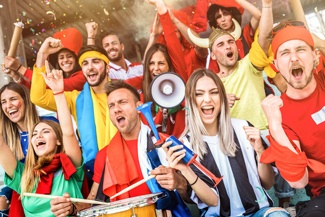Why don’t soccer fans see the same match?
 You’ll likely agree that criticizing the calls made by the referee is quite common among soccer fans. Team A’s fans think that the guy in black hasn’t called enough fouls against the players of the opposing team, and the same goes for Team B’s fans! British researchers have taken a closer look into this phenomenon. Using brain imaging, they tried to explain how fans can have such widely diverging opinions on the same match.
You’ll likely agree that criticizing the calls made by the referee is quite common among soccer fans. Team A’s fans think that the guy in black hasn’t called enough fouls against the players of the opposing team, and the same goes for Team B’s fans! British researchers have taken a closer look into this phenomenon. Using brain imaging, they tried to explain how fans can have such widely diverging opinions on the same match. The study carried out by Timothy J. Andrews and his colleagues at the University of York’s Department of Psychology wanted to explore the neural basis of these group differences under natural conditions. The aim was to determine whether these differences could be localized in the sensory areas of the brain involved in the perception of the world or in other areas important to the interpretation of sensory information. And what better than a soccer match to try to map out differences of opinion in two groups of opposing fans?
The researchers recruited fans from two English soccer teams: Chelsea and Manchester United. On average, each participant had been supporting their team for 15 years and had seen the team play at the stadium at least 25 times. Comfortably installed in an MRI scanner, each participant was able to watch a kind of compilation of game excerpts between his team and the rival team. The scientists then observed and compared the brain activity of the two groups.
Strong correlations were found between all the participants in the brain areas directly involved in vision (primary and secondary visual cortex): no surprises there. This simply means that the fans all saw the same match (more specifically the same video). Interestingly, the results indicated significant differences between the two groups of fans in the higher brain areas. Tim Andrews, one of the study’s co-authors, explains: "in the frontal and subcortical regions of the brain—including areas known to be active in reward, self-identity and control of movement—there was a correlation between supporters of the same team, but significant differences between the groups.” Therefore, while all fans received the same sensory information, they interpreted it differently depending on whether they were for Chelsea or Manchester United.
More broadly, this study points to a whole array of cognitive processes ranging from motor control to social cognition and reward and that are important to the formation of social groups. The biggest differences were seen in the nucleus accumbens (the central region of the reward system). According to the authors of the research: “The results of our study offer new insight into the neural basis for group bias and the human tendency to feel comfort and reassurance when part of a group, alongside distrust of outsiders and rivals.”
Source: Timothy J Andrews, Ryan K Smith, Richard L. Hoggart, Philip IN Ulrich, André D. Gouws. “Neural Correlates of Group Bias During Natural Viewing”, in Cerebral Cortex, Oct. 2018 University of York website – “News” section: https://www.york.ac.uk/news-and-events/news/2018/research/its-a-beautiful-game/







